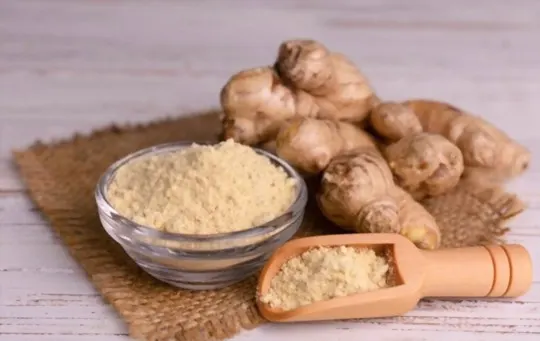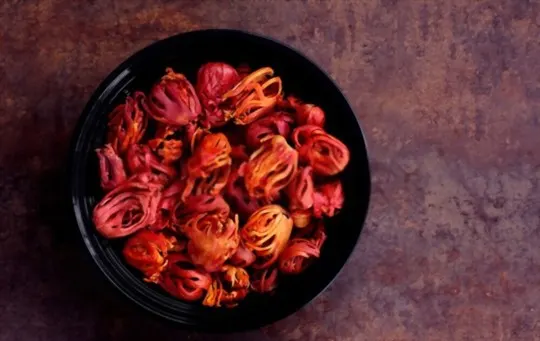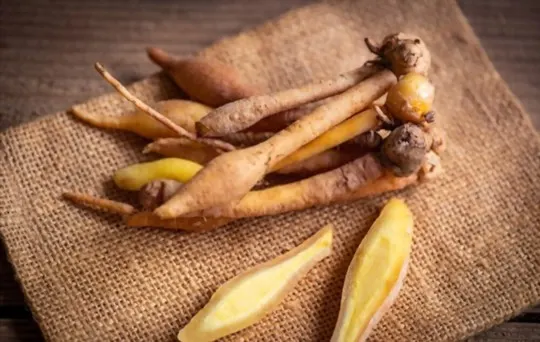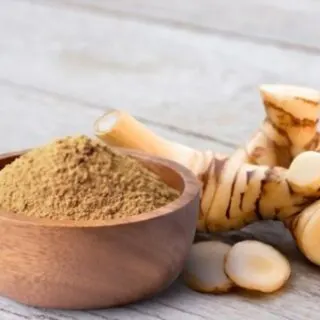Are you looking for a delicious replacement for galangal powder? Look no further.
In this blog, you’ll learn about the five best substitutes for galangal powder, helping you to create your favorite dishes without compromise.
Whether you’re in a pinch or simply have never heard of galangal before, this article has helpful information that everyone can benefit from.
Let’s explore the world of spice together.
What’s Galangal Powder?

Galangal powder, sometimes referred to as Thai ginger, is the dried and ground root of a plant native to Southeast Asia.
It has an herbal, spicy-sweet flavor and aroma, with a slight sting when eaten raw.
Galangal powder is used to season soups, curries and stir-fries, among other dishes.
It pairs especially well with ingredients like lemongrass, fish sauce and chilis.
Galangal powder features prominently in many traditional Southeast Asian recipes but it can sometimes be challenging to find or substitute for.
If you’re wondering what’s galangal powder and what are the best substitutes for it? This guide will provide you with everything you need to know about the ingredient and offer up the five best options for finding a suitable replacement when it’s not available.
In terms of taste characteristics, galangal powder offers subtle notes of warm cinnamon and pepper that bring a pleasant kick to food without overpowering other flavors.
Additionally, its pungent yet pleasant smell adds depth to more intricate dishes like curries or braised meats.
5 Best Galangal Powder Substitutes to Consider
However, it can be difficult to find in some parts of the world.
If you’re looking for a galangal powder substitute, check out our list of five options you should consider course turmeric root or turmeric powder:
1 – Fresh Galangal

Fresh galangal is the most natural substitute for galangal powder, and it should be available at most Asian supermarkets.
Fresh galangal has an earthy flavor that is said to be mildly spicy and peppery.
The texture is firm, with a pleasant crunch similar to ginger root, making it easy to grate or mince with a sharp knife before using in cooking.
Since fresh galangal will not have been dried or powdered, you may need to adjust the measurements called for in your recipe accordingly; 1 teaspoon of fresh galangal can be substituted for 1 tablespoon of pre-ground galangal powder.
Once grated into finer pieces, the spiciness and flavor are more concentrated than pre-ground varieties.
If you cannot find fresh galangal locally, many regional Asian markets will carry frozen varieties as well as pre-sliced forms packed in brine which can also work when making various curries and soups.
2 – Ginger Powder

Ginger powder is a widely available and fairly simple substitute for galangal powder.
Both spices have similar flavor notes, although ginger will be slightly more bitter than galangal.
Be aware that the flavor profile can be affected depending on which variety of ginger is used to make the powder (for example: Chinese or Indian-style ginger).
Additionally, ginger can provide more of a “punch” than galangal, so it may be best to start with less and adjust as needed.
Try this substitute in savory dishes such as stews, curries, or marinades.
3 – Mace and Cinnamon

Mace is the dried aril, or lacy coating that covers the nutmeg seed.
Its flavor is similar to nutmeg but slightly more floral, subtle and complex.
Mace has a unique sense of warmth that complements sweet treats and desserts perfectly – for instance, muffins, cakes and spiced cookies.
Cinnamon is dark brown in color and made from the inner bark of several tropical evergreen trees.
The spicy sweetness of cinnamon adds a unique warmth to many dishes like rice puddings, curries, fruity desserts as well as warm drinks like chai tea.
It pairs extremely well with sweet potatoes and squash dishes and can also be sprinkled over coriander seeds for an extra layer of flavor.
If you’re running low on galangal powder, don’t forget to add a little drop of cinnamon along with mace while cooking.
4 – Fingerroot

Fingerroot (also called Chinese ginger or lesser galangal) is closely related to galangal and it looks similar with its long, thin root.
It has pink-green skin and a creamy ivory flesh that’s tender enough to grate.
It’s used extensively in Southeast Asian cuisine for its unique flavor, offering an earthy aroma and sweet, peppery like undertone.
Fingerroot is less pungent than galangal and slightly softer so if your dish requires a long cooking time, you can partially substitute ½ teaspoon of fingerroot powder for every teaspoon of galangal powder.
Although fingerroot is not as widely available as other substitutes, you can buy it in some health food stores or online at specialty stores that sell it.
5 – Black or White Pepper

Black or white pepper is probably the most commonly used substitute for galangal powder.
Both black and white pepper have a spiciness that can help to replicate the peppery flavor of galangal powder, although neither can quite match the same distinct flavor.
Black pepper is recommended if you need an intense amount of heat, while white pepper should be used for a milder flavor.
You can also use a combination of both peppers for an even more complex flavor profile.
However, keep in mind that neither black nor white pepper will produce the unique citrusy flavors found in galangal powder.
Conclusion
In conclusion, galangal powder is an essential ingredient in many Southeast Asian dishes.
It brings an interesting earthy flavor and aroma to any dish, and can be difficult to find in local stores.
However, there are many great substitutes for galangal powder that can add a similar flavor profile, including ginger powder, turmeric powder, galangal root paste or fresh ginger.
No matter which substitute you choose, it’s important to adjust the amount of another ingredient if necessary or even use a combination of several alternatives for the fullest effect.
Additionally, there are many online stores that offer galangal powder shipped from Southeast Asia if you’re looking to experiment more with this incredible spice.

5 Best Galangal Powder Substitutes to Consider
Ingredients
- 1 – Fresh Galangal
- 2 – Ginger Powder
- 3 – Mace and Cinnamon
- 4 – Fingerroot
- 5 – Black or White Pepper
Instructions
- Choose your preferred substitute from the list of options.
- Organize all of your ingredients.
- Use the proper substitute to cook your recipes.

Carrie is a food writer and editor with more than 15 years of experience. She has worked for some of the biggest names in the food industry, including Bon Appétit, Food & Wine, and Martha Stewart Living.
As the Editor in Chief of IntroChicago.com, Carrie oversees all of the content on the site. She also manages the team of contributing writers and editors, who help to create delicious recipes, helpful tips, and informative articles that you’ll find on the site.
A native of the Chicago area, Carrie is passionate about all things food. She loves trying new restaurants and experimenting with new recipes in her kitchen. She’s also a graduate of the Culinary Institute of America, so she knows a thing or two about food!
